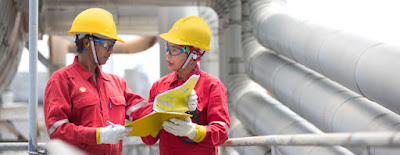Radiography
is used in a very wide range of aplications including medicine, engineering,
forensics, security, etc. In NDT, radiography is one of the most important and
widely used methods. Radiographic testing (RT) offers a number of advantages
over other NDT methods, however, one of its major disadvantages is the health
risk associated with the radiation. In general, RT is method of inspecting
materials for hidden flaws by using the ability of short wavelength
electromagnetic radiation (high energy photons) to penetrate various materials.
The intensity of the radiation that penetrates and passes through the material
is either captured by a radiation sensitive film (Film Radiography) or by a
planer array of radiation sensitive sensors (Real-time Radiography). Film
radiography is the oldest approach, yet it is still the most widely used in
NDT.
Principles
of Radiographic Testing
In
radiographic testing, the part to be inspected is placed between the radiation source
and a piece of radiation sensitive film. The radiation source can either be an
Xray machine or a radioactive source . The part will stop some of the radiation
where thicker and more dense areas will stop more of the radiation. The
radiation that passes through the part will expose the film and forms a
shadowgraph of the part. The film darkness (density) will vary with the amount
of radiation reaching the film through the test object where darker areas
indicate more exposure(higher radiation intensity) and liter areas indicate
less exposure (higher radiation intensity).This variation in the image darkness
can be used to determine thickness or composition of material and would also
reveal the presence of any flaws
Advantages
- Both surface and internal discontinuities can be detected.
- Significant variations in composition can be detected.
- It has a very few material limitations.
- Can be used for inspecting hidden areas (direct access to surface is not required)
- Very minimal or no part preparation is required.
- Permanent test record is obtained.
- Good portability especially for gamma-ray sources.
Uses
Industrial Radiography inspection is used to detect
features of a component or assembly that exhibit a difference in thickness or
physical density as compared to surrounding material. Large differences are
more easily detected than small ones. In general, radiography can detect only
those features that have an appreciable thickness in direction parallel to the
radiation beam. This means that the ability of the process to detect planar
discontinuities such as cracks depends on proper orientation of the test piece
during testing. Discontinuities such as voids and inclusions, which have
measurable thickness in all directions, can be detected as long as they are not
too small in relation to section thickness. In general, features that exhibit a
2% or more difference in absorption compared to the surrounding material can be
detected. Radiography is more effective when the flaws are not planar.
Applicability
Radiographic testing is used extensively on castings
and weldments. Radiography is well suited to the testing of semiconductor
devices for cracks, broken wires, unsoldered connections, foreign material and
misplaced components. Sensitivity of radiography to various types of flaws
depends on many factors, including type of material, type of flaw and product
form. Both ferrous alloys can be radio graphed, as can non-metallic materials
and composites.
Scope
of Radiographic Testing Course
Industrial radiographers, also known as industrial
radiography radiation safety personnel or industrial radiography testers, use
X-ray and gamma ray technologies to test and inspect metals in engineered or
manufactured products, pipes, walls and other materials.
Are you searching for NDT Course.Blitz Academy is the best ndt institute in kochi with ISO Certification and also offering 100% job assurance.

























